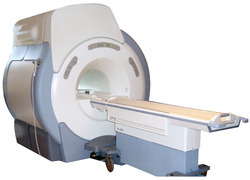 An MRI machine is used to create detailed images of the interior of a patient’s body. It provides slightly different information when compared with a CT scan and is more able to visualize problems involving soft tissues. The machine uses a strong magnetic field and radio frequency energy to vibrate water molecules in the body and it senses their distribution.
An MRI machine is used to create detailed images of the interior of a patient’s body. It provides slightly different information when compared with a CT scan and is more able to visualize problems involving soft tissues. The machine uses a strong magnetic field and radio frequency energy to vibrate water molecules in the body and it senses their distribution.
The MRI machine can help diagnose issues that involve problems with the structure of soft tissues, such as the gastrointestinal tract, and to locate interference between organs, or the presence of cancers. The result of the scan is a series of images which represent two dimensional slices of the patient’s body. These are interpreted by an expert.
The process of taking an MRI scan is more time consuming than a CT scan. Also, the patient must spend some time in a very tight space and many people find this very claustrophobic.
Typically the preparation for a bowel scan using an MRI involves drinking a fairly large quantity of a contrast agent after having no food or drink for a few hours. This allows the machine to more easily image the gut. After this an IV is placed in the patient so that a contrast agent can also be injected into the body during the scan. Also it is important that the patient has no metallic objects on their body because these might be a liability when exposed to the extremely intense magnetic field which is used.
It is necessary for the patient to lie on a narrow table and be bundled up tightly so that they cannot really move. The MRI antenna is also placed on top of the patient’s body. Eventually the patient will be slid into the machine and the MRI will take place. This involves the patient holding their breath for sets of scans lasting 20 seconds or so. This is done so that the patient stays very still at the moment of each scan, which avoids corrupting the images. The machine make a lot of loud and bizarre noises. The patient has access to a panic button in case they have any issues while they are inside the machine. In addition there is an intercom which is used by the operator to give instructions to the patient and inform them of what is happening.
The primary risk of this procedure is that there might be an bad health reaction to the contrast agent, although this is rare. MRIs use a different contrast agent to the one that is used for CT scans, so if you are allergic to one, you most likely will not be allergic to both.
